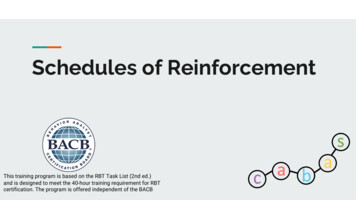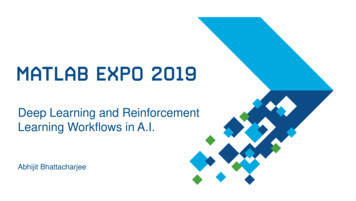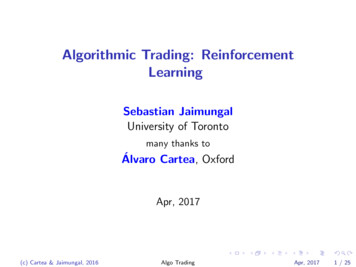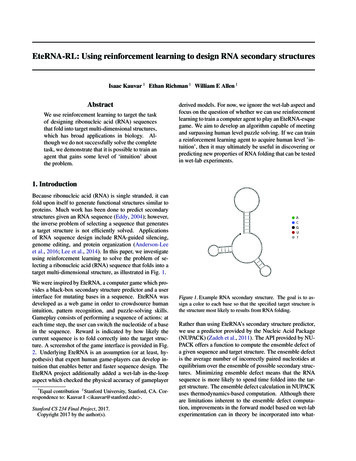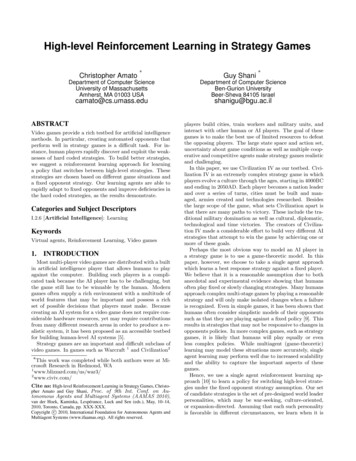
Transcription
High-level Reinforcement Learning in Strategy GamesChristopher Amato Department of Computer ScienceUniversity of MassachusettsAmherst, MA 01003 USADepartment of Computer ScienceBen-Gurion UniversityBeer-Sheva 84105 Video games provide a rich testbed for artificial intelligencemethods. In particular, creating automated opponents thatperform well in strategy games is a difficult task. For instance, human players rapidly discover and exploit the weaknesses of hard coded strategies. To build better strategies,we suggest a reinforcement learning approach for learninga policy that switches between high-level strategies. Thesestrategies are chosen based on different game situations anda fixed opponent strategy. Our learning agents are able torapidly adapt to fixed opponents and improve deficiencies inthe hard coded strategies, as the results demonstrate.Categories and Subject DescriptorsI.2.6 [Artificial Intelligence]: LearningKeywordsVirtual agents, Reinforcement Learning, Video games1.Guy ShaniINTRODUCTIONMost multi-player video games are distributed with a builtin artificial intelligence player that allows humans to playagainst the computer. Building such players is a complicated task because the AI player has to be challenging, butthe game still has to be winnable by the human. Moderngames often supply a rich environment with a multitude ofworld features that may be important and possess a richset of possible decisions that players must make. Becausecreating an AI system for a video game does not require considerable hardware resources, yet may require contributionsfrom many different research areas in order to produce a realistic system, it has been proposed as an accessible testbedfor building human-level AI systems [5].Strategy games are an important and difficult subclass ofvideo games. In games such as Warcraft 1 and Civilization2 This work was completed while both authors were at Microsoft Research in Redmond, WA1www.blizzard.com/us/war3/2www.civiv.com/Cite as: High-level Reinforcement Learning in Strategy Games, Christopher Amato and Guy Shani, Proc. of 9th Int. Conf. on Autonomous Agents and Multiagent Systems (AAMAS 2010),van der Hoek, Kaminka, Lespérance, Luck and Sen (eds.), May, 10–14,2010, Toronto, Canada, pp. XXX-XXX.Copyright c 2010, International Foundation for Autonomous Agents andMultiagent Systems (www.ifaamas.org). All rights reserved.players build cities, train workers and military units, andinteract with other human or AI players. The goal of thesegames is to make the best use of limited resources to defeatthe opposing players. The large state space and action set,uncertainty about game conditions as well as multiple cooperative and competitive agents make strategy games realisticand challenging.In this paper, we use Civilization IV as our testbed. Civilization IV is an extremely complex strategy game in whichplayers evolve a culture through the ages, starting in 4000BCand ending in 2050AD. Each player becomes a nation leaderand over a series of turns, cities must be built and managed, armies created and technologies researched. Besidesthe large scope of the game, what sets Civilization apart isthat there are many paths to victory. These include the traditional military domination as well as cultural, diplomatic,technological and time victories. The creators of Civilization IV made a considerable effort to build very different AIstrategies that attempt to win the game by achieving one ormore of these goals.Perhaps the most obvious way to model an AI player ina strategy game is to use a game-theoretic model. In thispaper, however, we choose to take a single agent approachwhich learns a best response strategy against a fixed player.We believe that it is a reasonable assumption due to bothanecdotal and experimental evidence showing that humansoften play fixed or slowly changing strategies. Many humansapproach complex multi-stage games by playing a reasonablestrategy and will only make isolated changes when a failureis recognized. Even in simple games, it has been shown thathumans often consider simplistic models of their opponentssuch as that they are playing against a fixed policy [9]. Thisresults in strategies that may not be responsive to changes inopponents policies. In more complex games, such as strategygames, it is likely that humans will play equally or evenless complex policies. While multiagent (game-theoretic)learning may model these situations more accurately, singleagent learning may perform well due to increased scalabilityand the ability to capture the important aspects of thesegames.Hence, we use a single agent reinforcement learning approach [10] to learn a policy for switching high-level strategies under the fixed opponent strategy assumption. Our setof candidate strategies is the set of pre-designed world leaderpersonalities, which may be war-seeking, culture-oriented,or expansion-directed. Assuming that each such personalityis favorable in different circumstances, we learn when it is
Figure 1: Screenshot of troops and cities in Civilization IVbest to use which personality. This approach allows us toleverage the existing low-level knowledge and learn a higherquality policy.We perform this learning based on state features such asthe difference in military strength between the player andopponent(s), the amount of unoccupied land remaining etc.This allows the agent to learn a policy by evaluating thedifferent strategies given the current game state and choosing the one that performs best in each given situation. Weexperiment with a set of basic reinforcement learning methods [11], such as Q-learning [13] and model-based Dyna-Q[10], using a fixed set of state features. We demonstrate thateven in this complicated game, reinforcement learning canbe used to improve hard-coded AI players.The remainder of the paper is organized as follows. Wefirst provide background on Civilization IV as well as ourlearning framework which is based on Markov decision processes (MDPs) and reinforcement learning. We then discussour approach for using reinforcement learning in CivilizationIV. In section 4, we describe our experimental results, showing that performance can be increased after a small numberof learning episodes when playing against a fixed policy. Finally, we supply an overview of the related work on AI invideo games and then conclude.2.BACKGROUNDWe first discuss the Civilization IV game, and then provide an overview of reinforcement learning in general andMarkov decision processes in particular.2.1Civilization IVThe testbed we chose was the turn-based strategy gameCivilization IV. As mentioned above, Civilization IV is avery large and complex game where players become a nationleader and evolve their civilization in an attempt to defeat asingle or multiple enemies. The player interacts with otherleaders through war, commerce, technology exchange andpacts. Movement of troops can be seen in Figure 1, while acommon negotiation can be seen in Figure 2.In Civilization, the player has a very large set of possibleFigure 2: Screenshot of a negotiation in CivilizationIVactions. For example the player can build one of dozensof buildings and units in each of his cities, research a hugetree of technologies, move units between cities and attackthe opponent cities. In this paper we choose to take a highlevel view of the game, allowing the game to automaticallyhandle these low-level decisions, and focus only on choosinga high-level strategy for winning the game.The built-in AI strategies for Civilization IV are createdin the form of historic leader personalities. For example,Genghis Khan is war-seeking, while Gandhi attempts to winthrough cultural or diplomatic leadership. These leadershave two types of differences. First, as we mentioned previously, each leader has a different personality that emphasizesa different strategy for winning the game. Second, leadershave different sets of bonuses, such as special units that onlythey can create, reduced maintenance costs for buildings,or stronger army units. The designers of the game havematched each personality with appropriate bonuses that arebeneficial under the personality strategy. The game designers have made these choices in order to give players a feel ofthese historic leaders, but as these strategies follow a “personality”, they may not be the best method for winning thegame. While imperfect, we note that these built-in AI leaders are extremely hard to win against. In fact, the humbleauthors admit that they were unable to win the game after many hours of gameplay at the mediocre “Prince” level,which we experimented with.It is reasonable that different situations in the game mayrequire different personalities to handle. For example, whenthe world is still unexplored, it may be beneficiary to use apersonality that emphasizes growth, and when the opponentbecomes weak it may be appropriate to become war-seeking,build an army and crush its civilization. While the initialbonuses are fixed, humans often change their personality andthus their strategy for winning the game given the conditionsthey observe. Therefore, our approach seeks to create a moreintelligent, human-like opponent.While the specific details of the world state in CivilizationIV are often hidden from the players, through the so-calledfog of war, many global details are available. The player can
at any time view a set of scores for military power, technological advancement, population and so forth for each of theother players. These scores can help the player to understand its relative weaknesses and strengths and make educated decisions. We make use only of these available worldfeatures, thus creating “fair” automated players that operate under the same limitations that a human has. The gamealso synthesizes a score from all these various components,which we will use as the basis for rewarding the player.One of the main reasons that Civilization IV was chosen was because the game developers have published a largeportion of the game source code as an SDK3 . This SDK allows adding new civilizations, units, and buildings as well aschanging the gameplay and AI behavior. We used this publicly available SDK to interact with the game and implementour various learning procedures.2.2Markov decision processesFor learning, we choose to use Markov Decision Processes(MDPs) [6] as the general framework. MDPs are a common method for modeling sequential decision-making withstochastic actions. We learn a policy for an MDP throughreinforcement learning approaches.We represent the learning problem as an MDP, defined asa tuple hS, A, P, Ri with: S, a finite set of states with designated initial state s0 . A, a finite set of actions. P , a set of state transition probabilities: P (s0 s, a),the probability of transitioning from state s to s0 whenaction a is taken by the agent. R, a reward function: R(s, a), a real-valued immediatereward for taking action a in state s.An MDP unfolds over a series of steps. At each step, theagent observes the current state, s, chooses an action, a,and then receives an immediate reward that depends on thestate and action, R(s, a). The agent begins in the initialstate s0 , which is assumed to be known. The state transitions according to the distribution P as given above and theprocess continues. The goal is to find a policy, which is amapping, π, from states to actions, that maximizes the sumof rewards over the steps of the problem. In this paper, weconsider the infinite horizon problem which unfolds over aninfinite number of steps. To maintain a finite sum, a discount factor γ [0, 1) is used. The value of a policy π atstate s can be calculated as:V π (s) R(s, π(s)) γXP (s0 s, π(s))V π (s0 )sWhere π : S A is a mapping from states to actions according to policy π.2.3Reinforcement learningWhen we do not know the transition and reward models,we can use reinforcement learning methods to learn a policy.Reinforcement learning is an approach to learn policies foragents acting in an unknown stochastic world, observing thestates that occur and the rewards that are given at each reDLL v161.zip2.3.1 Q-learningThe first approach we use is Q-learning [13]. This methodupdates the value of a state-action pair after the action hasbeen taken in the state and an immediate reward has beenreceived. Values of state-action pairs, Q(s, a) are learnedbecause the resulting policy is more easily recoverable thanlearning the values of states alone, V (s). Q-learning willconverge to an optimal value function under conditions ofsufficiently visiting each state-action pair, but often requiresmany learning episodes to do so [14].When an action a is taken in state s, the value of a stateaction pair, or Q-value, is updated as Q(s, a) Q(s, a) α r γQ(s0 ) Q(s, a)where α [0, 1] is the learning rate, r is reward that isobserved, γ is the discount factor, s0 is the next state, andQ(s) maxa Q(s, a).The actions are taken according to some exploration policy, such as an -greedy approach. This method chooses theaction that maximizes the Q-value with probability 1 anda random action with probability . These policies are chosen in order to balance the exploration of uncertain statesand actions with the exploitation of the current policy. Itis also common in a stationary environment to decay theexploration rate ( ) as a policy is learned as another way tobegin to deal with this tradeoff.In multiagent domains, Q-learning is no longer guaranteed to converge due to the environment no longer beingstationary. Nevertheless, it has been shown to be effective[8, 12]. When the other players use fixed policies, they can beconsidered part of the environment and the problem againbecomes an MDP. In this case, the Q-learner will learn abest response policy. Thus, Q-learning is optimal in thecase when the other players do not change policies and canbe robust to situations in which they do.2.3.2Model-based Q-learningQ-learning is a model-free method. That is, it learns apolicy directly, without first obtaining the model parameters— the transition and reward functions. An alternative is touse a model-based method that learns the model parametersand uses the model definition to learn a policy.Learning a model consists of learning the transition probabilities and reward values for each state and action. If agood model is learned, an optimal policy can be found byplanning methods because the model parameters are nowknown. Rather than first building a correct model and thenfinding a policy from that model, we learn the model andthe Q-values at the same time with the Dyna-Q approach[10].Dyna-Q can learn the Q-values more quickly than Qlearning by using the model to generate learning experiencesand does not require a model to be fully learned before apolicy can be found. Thus, the agent learns both the Qvalues and the model through acting in the environment.The model is then used to simulate the environment andthe Q-values are updated accordingly. As the model becomes a better representation of the problem, the Q-valueswill be more accurately updated and convergence will occur more quickly. The Dyna-Q algorithm operates exactlylike Q-learning, except for the addition of model learning
Algorithm 1: Dyna-Qinput : current Q-values, Q, immediate reward r,state s and action aoutput: updated Q-values, QbeginQ(s, a) Q(s, a) α(r γQ(s0 , a0 ) Q(s, a))P (s0 s, a) updatePAverage(s, a, s0 )R(s, a) updateRAverage(s, a)for i 0 to numIter dos0 randomPreviouslySeenS ()a0 randomPreviouslyTakenA(s0 )s00 sampleFromModel (s0 , a0 )r0 fromModel (s0 , a0 )Q(s0 , a0 ) Q(s0 , a0 ) α(r γQ(s00 , a00 ) Q(s0 , a0 ))return Qendand an offline planning phase at each step. These additionsallow learning to take place without an explicit model learning phase because the model and Q-values are learned simultaneously. Nevertheless, the inclusion of a model allowslearning to be hastened.Dyna-Q is shown in Algorithm 1. First the regular Qlearning update takes place and the probability and rewardmodels are updated as averages given the new information.That is, the transition probability is the number of times s0occurs after being in state s and taking action a divided bythe number times the agent was in state s and chose actiona:P (s0 s, a) count(s, a, s0 )/count(s, a)The reward value is the average of the rewards received instate s after choosing action a:R(s, a) (count(s, a) R(s, a) r)/(count(s, a) 1)The model sampling occurs in the for loop. For some designated number of iterations the model is sampled and theQ-values are updated accordingly. This is done by first uniformly choosing a state that has been previously encountered, s0 . An action, a0 , that has been taken in s0 is thenuniformly chosen and based on the transition model, a resulting state s00 is sampled. The reward for s0 and a0 is thenfound from the reward model. These values are then usedto update the appropriate Q-values.2.3.3Factored state representationsIn many environments states can be described as an assignment to state features [4]. If there is some independencebetween feature transitions or rewards, this representationcan provide significant power in learning over fewer episodes.However, assuming independence between features that arein fact dependent can cause us to learn an improper modeland thus an imperfect policy.Assuming that features transition independently, we canwrite:nYP (s0 f10 , ., fn0 s, a) P (fi0 s, a)i 1P (fi0 s, a)whereis the probability of feature fi after actiona has been taken in state s.The transition functions for each one of these featurescan then be learned independently of the others in Dyna-Q.That is, rather than learning P (s0 s, a), we learn separatefunctions for each P (fi0 s, a). This reduces the transitionmodel parameters from S 2 A to F S A , where F isthe number of features. Thus, we require fewer learningepisodes in order to learn the model parameters, leading tofaster learning.3.A REINFORCEMENT LEARNINGAPPROACH FOR CIVILIZATION IVThe basis of our approach is to learn a policy for switchingbetween high-level strategies. During each game, the agentobserves certain current game information. Based on thisinformation, the agent chooses a strategy — a leader personality — for the next step. At this next step, the agentreceives a reward, again observes the new game informationand chooses a strategy again. If the game is played again,the learning continues. Below, we consider a game with onlytwo players, but the approach could be generalized to anynumber of players.3.1Learning in CivilizationAs we explain above, we focus here on the question ofproperly selecting a strategy given the current game conditions. This is done by learning the value of playing each ofthe different leader personalities in different game scenarios.Given these values, we can choose the personality with thehighest value in the current condition. This approach canproduce an AI system that performs better against a humanopponent and allow game developers to automatically mixa set of fixed strategies in order to form a higher qualitypolicy.We assume here that a human will play a fixed strategy(however complicated), as was discussed previously. Evenagainst a fixed opponent, it is crucial to learn quickly. Whilewe assume the game will be played repeatedly, we cannotexpect a human to play hundreds of games while waiting forthe AI to improve. Thus, we develop an approach that doesnot require a large number of training episodes in order toproduce an improved policy.3.2Modeling Civilization as an MDPBecause choosing a high-level strategy may require several game turns to bear fruit, we allow strategy switching(an MDP step) only every few turns. The new strategy isallowed to run for this fixed number of turns, after which weobserve the outcome. In our case, a decision is made every10 turns, resulting in at most 46 steps per game. The detailsof how the states, actions and rewards are represented areexplained below.It should be noted that these parameters were chosenbased on educated guesses after playing the game, but extensive analysis was not conducted. It is quite likely thatthese could be improved, which would also improve the performance of the resulting algorithms. Our goal was to choosea simple and general model that is not dependent on “tweaking” of the parameters.3.2.1State space
We define the state space with a set of four state features:population difference, land difference, military power difference and remaining land. We call these features f1 , f2 , f3and f4 and calculate their values based on the scores provided in the game. These features were chosen because theyprovide very general information about the relative statusof a civilization. Also, each player has access to these valuesand can compute the resulting features. Because we considergames with two players, the difference features are thereforethe difference in score between the two players, while theremaining land is found by subtracting the land currentlyoccupied by both players from the total amount of land inthe game.States are then discretized over the possible values. Forpopulation, land and power differences, the feature was givenone of three values based on the difference in scores. Thatis8 2,fi 1, :0,if diff 10if 10 diff 10if diff 10where diff represents the difference in value between theagent and the opponent. For example, if the difference inpower between the players is 26, f3 2. The remaining landfeature has three values as well, determined by whether thereis over 50% of land remaining, between 20% and 50% or lessthan 20%. Again, this discretization was chose to be general,but increased performance could likely be achieved by usingdifferent intervals for each feature. Combining these featuresproduces 81 possible states.3.2.2Action spaceAs we explain above, an action is a choice of a new strategy for making low-level decisions. We use the set of built-inpersonalities as the allowed strategies. We limited our action space to four leaders: George Washington, Frederick II,Mahatma Gandhi and Genghis Kahn. These leaders werechosen because they possess each of the eight possible personality traits and have diverse preferences for war, buildings etc. Washington is Financial and Organized, Frederickis Creative and Philosophical, Gandhi is Industrious andSpiritual and Genghis Kahn is Aggressive and Expansive.These traits, along with other heuristics, define preferencesfor each leader. These leaders can be seen as they appear inthe game in Figure 3.3.2.3Reward modelWe define the immediate reward given at each step basedon the score provided by the game. That is, the immediatereward is the difference in total score between the agents.This measures how the agent is playing in relation to theopponent. While it is possible to lose the game while havinga higher score than the opponent, the score is obviouslyhighly correlated with the final outcome of the game. Thisreward was chosen in pursuit of our goal to produce a playerthat adapts its policy and wins more often. We define thedifference in score asthisStepScore myT otalScore yourT otalScore3.3Learning approachesFigure 3: Leaders in Civilization IV (clockwise fromtop left): Frederick II, Mahatma Gandhi, GenghisKahn and George WashingtonIn this paper we used basic reinforcement learning methods. This was done to demonstrate the applicability of reinforcement learning to the problem of strategy selection.Thus, it is likely that more advanced methods will providebetter results. The approaches we used were those discussedabove: Q-learning, Dyna-Q, and Dyna-Q over the factoredstate space. The code implementation for these methods,which provides a framework for reinforcement learning inCivilization IV is available at:http://www.cs.umass.edu/ camato/Civ4.html4.EXPERIMENTSTo demonstrate the applicability of our approaches, weperformed learning against a single AI opponent playing thefixed policy provided by the game. We seek to determineif the game policies can be improved by our learning methods. We note again that at the “Prince” level which weexperimented with, winning against the built-in AI is verychallenging. Each game was played in the small “duel” sizedmap with the standard game speed, starting era, water leveland climate. Our learners started with a random policyand learned over 50 and 100 training episodes. 500 testing episodes were then used to determine the quality of thelearned policy.The parameters used in each of our learning algorithmswere α 0.25, γ 0.9, 0.2 for training, while 0.0 was used for testing. For both the flat and factoredversions of Dyna-Q, 25 steps of learning from the modelwere used at each step of the problem. It is also worthnoting that all of these methods used very little computationtime. The most computationally intensive method, the flatmodel-based Dyna-Q, added only about one second at each
problem step. Thus, all of these learning methods would be!")%transparent to an end user playing the game.For the experiments, we provide results for playing Freder!"'#%ick against Washington and Gandhi against Genghis Kahn.We selected these pairs because they represent very differ!"'%ent approaches for winning the game. In addition to thepreferences and characteristics of the leaders, initial bonuses!"##%are given in the form of beginning technology and %%%%%%%.5672%troops. These bonuses remain fixed even when the %%%%%%%/01234%!"#%ality changes.To determine the improvement over these fixed strategies!"&#%in the game, we first determined the percentage of gameseach leader would win against the chosen opponent. This!"## %!"#&'%!"'!'%!"'('%!"#)*%!"# %standard policy is referred to as fixed in the figures and ta!"&%,%#!%,%(!!%-%#!%-%(!!%.-%#!%.-%(!!%bles below, while a random policy which randomly chooses aleader personality at each step is called random. These wererun 1000 times to improve the precision of the resulting esFigure 4: Results of Frederick learning to playtimates. To determine if each learner’s policy is better thanagainst Washingtonthat of the fixed or random policies, we compare them usinga one-tailed Welch’s t-test. This test accounts for possiblyRandomFixeddifferent variances, but due to large sample sizes, similart-value p-value t-value p-valuetests will likely have similar erick vs. WashingtonM503.480.00052.410.01When playing Frederick against Washington without anyM1003.860.00012.790.005learning, Frederick won 54.1% of the time. A random policyFM502.430.011.360.1started as Frederick won 51.2% of the time. Figure 4 showsFM1002.950.0051.880.05the results of the different learning methods after 50 and100 steps of learning and the mean number of games wonby the fixed and random policies. Confidence intervals ofTable 1: The significance of results for Frederick vs.95% are also included in each bar of the figure. Table 1Washington. Results significant at the 0.05 level ordescribes the statistical significance of these results. The tbeyond are in bold.values using Welch’s t-test are provided for both the randomand fixed polices along with the one-tailed p-values. Thesedencies that one would expect in the game. For instance,p-values are rounded up using standard intervals to increasewhere there is a power advantage for the learner, Genghisreadability. We consider results equal to or below 0.05 to beKahn will often be chosen. When the game is even and alstatistically significant and as a result, present them in boldmost all the land has been taken, Washington is often chofont.sen to stabilize the economy of the civilization and provideThe figure shows the percentage of games won by Qa balanced endgame.learning (Q), model-based learning (M) and learning withthe factored model (FM) after 50 and 100 learning episodes.Gandhi vs. Genghis KahnIn each case, the percentage won after learning was higherthan that of the fixed and random policies. When statistiIn these games, the fixed policy won 73.1% of the games,cal significance is also considered, model learning for both 50while a random policy won 77.6%. The high winning perand 100 episodes as well as the factored model after both 50centage is likely because Gandhi’s bonuses are stronger, butand 100 episodes are statistically significantly higher thanwe can see that Gandhi’s personality is often not the bestthe random policy with 95% probability or higher. Whenone to play in this situation. Figure 5 shows the results ofcompared to the fixed policy, model-based learning in botheach of the learners after 50 and 100 learning episodes ascases and the factored model after 100 episodes are statistiwell as the mean number of games won by the fixed andcally significantly higher. The other results are suggestive,random policies. We also provide 95% confidence intervalsbut may require more learning before becoming significantlyfor each case. Table 2 provides the statistical significance ofbetter than the fixed policy played by the game AI.these results.Here, the model learning (M) after both 50 and 100 learnThe results are in line with common expectations. Themodel allows the learner to improve at a faster rate, permiting episodes and the factored model learner (FM) after bothting the model-based learner to perform well with a small50 and 100 episodes are statistically significantly better thannumber of learning episodes. Likewise, the factored modelthe random policy. All learners are statistically significantlylearner will learn even more quickly, but because the indeb
the hard coded strategies, as the results demonstrate. Categories and Subject Descriptors I.2.6 [Arti cial Intelligence]: Learning Keywords Virtual agents, Reinforcement Learning, Video games 1. INTRODUCTION Most multi-player video games are distributed with a built in arti cial intelligenc


